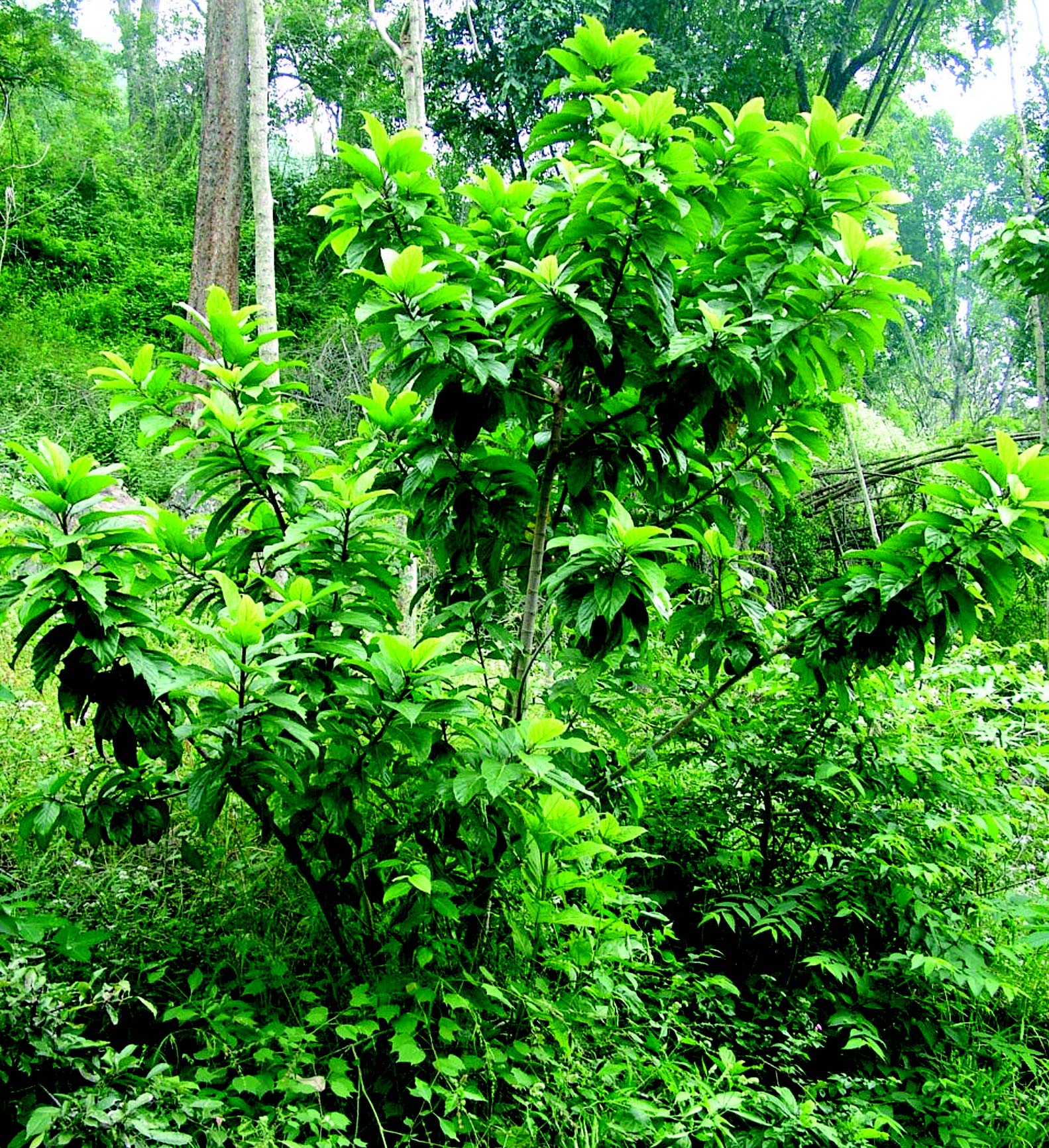Ficus hispida L.
Trees, to 10 m high laxly branched; bark grey, smooth; blaze yellow; exudation milky; young shoots hispid; internodes of branchlets hollow. Leaves simple, opposite; stipules 11-15 mm long, interpetiolar, ovate-lanceolate, cauducous, often in whorls of 4 on the receptacles with leafless branches; petiole 1-4 cm long, stout, hispid, with a subnodal gland; lamina 7-20 x 6-10 cm, oblong, obovate, elliptic-oblong, ovate-oblong or obovate-oblong, base round, subcordate or cuneate, apex abruptly acute or acuminate or cuspidate, margin subentire to minutely dentate, membranous, scabrid, hispid-pubescent; 3-5-ribbed from base, lateral nerves 5-6 pairs, pinnate, prominent, intercostae scalariform, prominent. Flowers unisexual; inflorescence a syconia, dioecious, fascicled on trunk or on elongated pendulous or trailing leafless branches, depressed-globose, base narrowed, sticky pubescent without, faintly ribbed; peduncle 5-15 mm long, stout; basal bracts 3, 1-1.5 mm long, subtriangular, orifice slightly raised, closed by 5-6 apical bracts and numerous small inner bracts; internal bristles absent, appressed lateral bracts when present 2-4 mm wide; male flowers and gall flowers in same receptacle; female flowers in separate; male flowers ostiolar, in 2 rings; tepals 3 broad; stamen 1, subsessile; anther oblong, parallel, unequal; female flowers sessile or stalked; perianth short, tubular to 2 mm, glabrous; ovary depressed-globose, superior, red-brown; style 1.5 mm long, hairy; stigma clavate; gall flowers same as female but larger and distinctly stalked. Syconium 2-2.5 cm across, yellow; achenes 1.5 mm, lenticular, keeled with prominent hilum.
- Family: Moraceae
- Habit: medium sized evergreen tree
- Habitat: Moist deciduous and semi-evergreen forests, also in the plains
- Status : common
Vernacular names
Assamese
Dimoru
Jagya-dimoru
Jongiya-dimoru
Khoksha-dimoru
Gujarati
Dhed Umbar
Hindi
Kagsha
Katgularia
Kala Umbar
Gobla
Phalgu
Kannada
Kada Atthi
Kad-atthi
Paare Mara
Karbi
Engthum
Konkani
Kharvoti
Malayalam
Erumanakku
Kattatthi
Paeyathi
Parakam
Pavakom
Perimteragam
Peyatti
Peyattiparaka
Thondi
Thonditherakam
Valliteragam
Erumanaakk
Kaattaththi
Paarakam
Marathi
Karavati
Kala Umbar
Dhed Umbar
Bokeda
Bokhada
Bokheda
Mishing
Takpi
Nepali
Kothaya-dumari
Other
Daduri
Devil Fig
Domur
Erumanakku
Hairy Fig
Opposite-leaved Fig-tree
Parakam
Peyatthi
Rough-leaved Fig
Sona-atthi
Sanskrit
Kakodumbarika
Phanika
Phalgu
Malayuhu
Tamil
Chona-atthi
Paeiathi
Pei-atthi
Peyatti
Telugu
Bomma-medi
bodo
Khoksha dumr
Medicinal Uses
All parts of this plant are found to be acrid, astringent, bitter, coolant and have activity against dysentery, ulcers, biliousness, psoriasis, anemia, piles and jaundice. Additionally, the fruit is known to be active as aphrodisiac, tonic, lactagogue and emetic.
